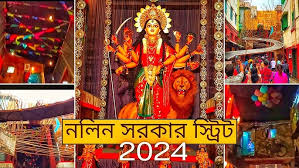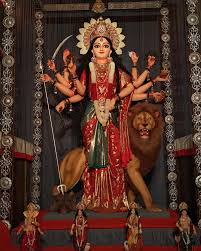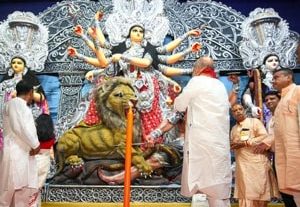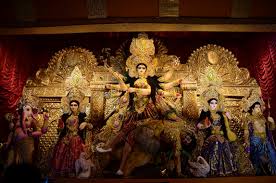Durga Puja in Kolkata is not merely a festival—it’s a living archive of the city’s memory. And in 2024, Nalin Sarkar Street Sarbojanin Durgotsab gifted the city a theme that feels both intimate and immense: Saharnama, literally, a “city-nama”—a lyrical naming of the city. From the first glimpse of the façade, where typographies of old shop signs bloom like fireflies, to the inner sanctum where Maa Durga sits amid textures of brick, tram steel, and handwritten postcards, this Puja reads like a poem. It is an ode to lanes and lives, to chai in earthen bhaar, to tram bells and radio crackle, to hopes scribbled on the back of bus tickets.
Sarbojanin Durgotsab gifted the city a theme that feels both intimate and immense: Saharnama, literally, a “city-nama”—a lyrical naming of the city. From the first glimpse of the façade, where typographies of old shop signs bloom like fireflies, to the inner sanctum where Maa Durga sits amid textures of brick, tram steel, and handwritten postcards, this Puja reads like a poem. It is an ode to lanes and lives, to chai in earthen bhaar, to tram bells and radio crackle, to hopes scribbled on the back of bus tickets.
A Quick Primer
- Location: Nalin Sarkar Street, North Kolkata (near Maniktala–Shyambazar belt; a snug lane that bursts into a festival artery during Puja).
- Organiser: Nalin Sarkar Street Sarbojanin Durgotsab.
- Essence of the Theme: Celebrating the city through fragments—signage, street typography, tram tickets, rooftops, verandahs, gossip corners, rickshaw wheels, water tanks, and rain-polished bricks.
- Vibe: Immersive, nostalgic, exquisitely handcrafted—mood-forward rather than spectacle-only.
- Best Time to Visit: Early evening before crowds peak, or very late night for long exposures and unhurried darshan.
The Concept: Why Saharnama Matters
Kolkata’s Pujas have explored nostalgia for decades, but Saharnama isn’t nostalgia for nostalgia’s sake. It refuses sepia tokenism. Instead, it zooms in on tactile urban detail—the gloss of khorin paint on an old shutter, the frayed edge of a hoarding, the geometry of lathi barricades, the conductive hum of overhead tram wires, the patina on brass bells. The effect is cumulative: as you walk, your senses collect a city’s thousand nicknames.
The curatorial choice is poetic. A city is rarely singular. It’s a chorus. Saharnama arranges that chorus: some voices are loud (the marquees, the lightscape), others are soft (the handwritten notes, the scuffs on the floor). It makes you listen with your eyes.
First Look: The Façade That Breathes
At street level, the pandal façade performs a clever trick. Instead of one dominant icon, it composes a collage of urban scripts. Imagine:
- Stencilled letters evoking factory gates.
- Hand-painted signboards with deliberately uneven kerning.
- Tram route numbers cut into metal lattices.
- Neon outlines of rooftops and water tanks.
- Lantern clusters that mimic windows lit at dinner time.
These are not props; they’re glyphs of lived life. Stand back and the wall becomes a skyline. Step closer and you read the micro-poems of the city.
Photography tip: Use a 35–50mm prime at dusk. Meter for highlights to retain neon detail. A step-stool (if allowed) gets you above the shoulder line of the crowd and clean horizontals.
The Processional Walk: From Street to Story
The entry corridor sets the libretto. Sound design is subtle: tram chimes, tea glasses chinking, a radio snatch of Rabindrasangeet, a burst of Puja announcements fading into monsoon rain. Lighting pools like puddles; each pool reveals a material essay—corrugated tin, cracked mosaic, a chalk alpona that reads like wayfinding.
We loved the intermittent shadow-play: cutouts of birds on telephone wires, silhouettes of laundry on a line, a cat leaping from parapet to parapet. They pass over you as you walk—gentle, fleeting, precious.
Pro tip: Slow down. The narrative isn’t linear; it swirls. You’ll spot different facets depending on your height, pace, and patience.
Inside the Pandal: A Chamber of City Textures
At the heart of Saharnama lies a material dramaturgy—walls that seem to breathe, floors that remember footfall. Surfaces combine:
- Burnished brick (not faux—crafted to feel weathered by decades of Durga Pujas).
- Metal grate motifs reminiscent of railings and manhole covers.
- Paper ephemera—bus tickets, postage, diary pages—laminated into artful mobiles.
- Fabric banners with serif and akkhor scripts—names of lanes, nicknames of para heroes, snippets of neighbourhood lore.
Light is not white. It’s tea-stained, sunset-amber, and rain-blue in passages, cueing you to shift mood. The ceiling is a showstopper: sprigs of wire, cable, and string, arranged like star maps of a city’s electrical constellation.
The Idol: Tradition Framed by the City
The pratima returns to a timeless idiom—a classical face, shola embellishments, and restrained palette—set against a backdrop that abstracts the skyline. Look for:
- Mahishasura with a shield that doubles as a traffic mirror—a witty nod to how the city watches itself.
- Lakshmi’s owl perched on a calligraphed lamppost.
- Saraswati’s veena with fret markers shaped like tram tokens.
- Kartik’s peacock iridescent in tin-emboss textures.
The message is clear: tradition is the city’s core firmware. The contemporary elements are frames, not the photograph.
Darshan etiquette: Keep moving gently, no flash near the idol, and follow the volunteer marshals. Offer your pranam without blocking the view for others—Puja is community choreography.
Sound, Scent, and the City’s Pulse
Saharnama excels at multi-sensory design. The audio isn’t wallpaper; it’s narrative. You’ll hear station announcements blur into conch and dhaak. You’ll smell incense braided with petrichor. Somewhere a kettle whistles. Somewhere a harmonium warms up. The sum is not loud—it’s enveloping.
Light & Shadow: The After-Dusk Transformation
After sunset, the pandal acquires a second skin. Neon linework outlines roof shapes; window grids flicker as if dinner has begun in a hundred homes. Shadow puppetry renders moving silhouettes—pigeons, clotheslines, slow-turning ceiling fans—like the city is dreaming overhead.
Photographers will relish the contrast discipline—bright accents nested in darkness. This allows cinematic frames even on smartphones. Try 1/4s to 1s handheld with stabilisation, nudging ISO just enough to avoid banding.
The Pathways: Crowd Flow as Design
 This Puja routinely draws heavy footfall, but crowd management is sympathetic to the local street grammar. Expect one-way loops, gentle barricades, and volunteers who act like ushers rather than guards. Look for resting pockets near the exit—tiny oases for seniors and kids.
This Puja routinely draws heavy footfall, but crowd management is sympathetic to the local street grammar. Expect one-way loops, gentle barricades, and volunteers who act like ushers rather than guards. Look for resting pockets near the exit—tiny oases for seniors and kids.
Tip for families: Early evenings on Sashthi–Saptami are kinder. Carry water, a small hand fan, and a mini power bank. Dress light; shoes you can stand in for hours.
Sustainability & Craft
Nalin Sarkar Street has long championed craft-forward builds. In 2024, the team leans into reclaimed materials—metal offcuts, paper reuses, wood from old scaffolds—without fetishizing “junk art.” The craft is respectful: surfaces feel soft to the eye and hand, edges are sanded, corners rounded. There’s care in how the city is held.
Behind the scenes: Many artisans hail from multi-generational craft families—patachitra painters moonlighting as signboard artists, glow-sign typographers who learned brush lettering from their parents, carpenters with memories of building pandals in the 90s. Saharnama is as much their biography as it is Kolkata’s.
Food Trail: City on a Plate
To write a city’s name, you must taste it. Around Nalin Sarkar Street, pop-up food kiosks and nearby eateries shape a perfect pandal-hopping snack loop. Expect:
- Phuchka with tangy tamarind jol.
- Kathi rolls (egg-chicken classic; ask for a light smear of sauce to keep it crisp).
- Telebhaja (beguni, peyaji) for monsoon mood.
- Jilipi & chomchom for a sugar lift.
- Chai in bhaar—clay cups that keep fingers warm and photos iconic.
Hydration tip: Alternate chai with water—October evenings can still be humid. Dispose of bhaar responsibly in designated bins.
Ritual Highlights: Faith in Motion
Durga Puja is rhythm. On Saptami, the Nabapatrika—nine plants bound as one—arrives like a green whisper of the countryside into the city’s concrete heart. On Ashtami, the pushpanjali brings palms and petals together; many visitors time their darshan for this. Sandhi Puja at the cusp of Ashtami and Navami casts the pandal in lamp-gold—arguably the most sacred 48 minutes of the Puja.
Volunteers maintain a quiet, patient flow during rituals. If you’re new, follow cues: shoes off where indicated, hands washed if participating in prasad, phones on silent during aarti. The guiding spirit here is respect.



